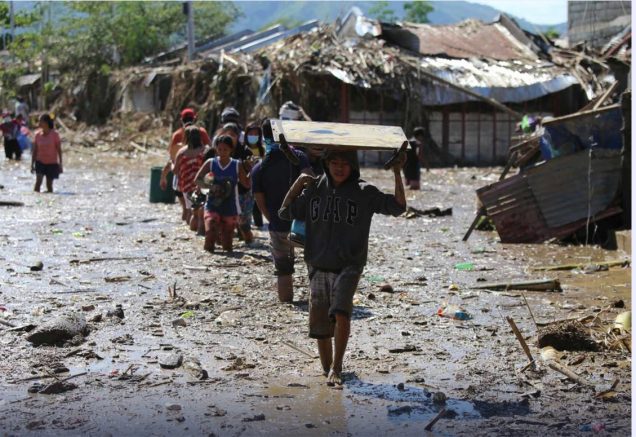On the criminal negligence of the Duterte government in typhoon Ulysses
On the criminal negligence of the Duterte government in typhoon Ulysses

Residents of Barangay San Jose, Rodriguez, Rizal walks through the muddy road on Nov. 13, a day after the onslaught of Typhoon Ulysses. (Photo: Inoue Jaena/Rappler)
By Renato Reyes Jr.
1. There was a general lack of disaster preparedness and urgency on the part of the NDRRMC which failed to warn the people of the dangers brought by typhoon Ulysses. Unlike typhoon Rolly, there was no high alert and no massive pre-emptive evacuation undertaken prior to Ulysses. This much can be seen from the Twitter feed and situation reports from the NDRRMC. As far as the public is aware, there was no cabinet-level meeting to prepare for the onslaught of Ulysses. Bicol was already being flooded during the day of November 11 but no major evacuation took place in Metro Manila and Rizal. Thousands were trapped or stranded in their homes during the massive flooding.
2. There were no prepositioned rescue units and equipment, thus the extreme difficulty in rescuing the thousands who were trapped in their homes in the morning of November 12. LGU’s were overwhelmed and requested assistance from the national government and the private sector.
3. There was no national government oversight on the release of water from the dams. Some protocols were not observed before the typhoon arrived. Instead of a graduated early discharge of water, dams resorted to massive discharge on the day of the typhoon thus flooding entire communities. Cagayan and Isabela are examples of flooding caused by the massive release of water from Magat Dam. This is the worst flooding in the history of the region. Who from the national government is ultimately responsible in overseeing the multiple releases from dams?
4. The cabinet-level meeting happened only on November 13, with officials issuing conflicting death counts, showing again a lack of coordination among agencies. In the matter of deaths, the casualties of Ulysses have exceeded those of Rolly. Meanwhile, the Office of the Vice-President coordinated rescue efforts in Cagayan and Isabela in the evening of November 13 and made public updates. During this critical time, other officials from the national government were neither seen nor heard.
5. The President appeared briefly on November 12 to say he wanted to go out and swim with the trapped people but that he was being prevented by his security. The President appeared briefly again on November 14, in the aftermath of the worst flooding of Cagayan, this time to tell the public he will create a “task force” to help the flood victims, even though an inter-agency body, the NDRRMC already exists.
6. The national government has yet to take responsibility for failing to stop or regulate certain activities such as quarrying which contributed to soil erosion and flooding in areas like Rizal. It should also be noted that calamity funds of the NDRRMC for the year 2020 was slashed by P4 billion.
7. When the situation stabilizes, an independent investigation must be conducted on the lapses and failures in government’s preparations in relation to Ulysses. There needs to be accountability to prevent a repeat of the disastrous handling of the typhoon and its aftermath.
Source: Facebook post of Renato Reyes, Jr.
Comments (0)